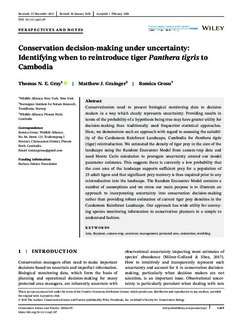Conservation decision-making under uncertainty: Identifying when to reintroduce tiger Panthera tigris to Cambodia
Peer reviewed, Journal article
Published version

Åpne
Permanent lenke
http://hdl.handle.net/11250/2643174Utgivelsesdato
2020Metadata
Vis full innførselSamlinger
- Scientific publications [1392]
Originalversjon
10.1111/csp2.187Sammendrag
Conservationists need to present biological monitoring data to decision makers in a way which clearly represents uncertainty. Providing results in terms of the probability of a hypothesis being true may have greater utility for decision-making than traditionally used frequentist statistical approaches. Here, we demonstrate such an approach with regard to assessing the suitability of the Cardamom Rainforest Landscape, Cambodia for Panthera tigris (tiger) reintroduction. We estimated the density of tiger prey in the core of the landscape using the Random Encounter Model from camera-trap data and used Monte Carlo simulation to prorogate uncertainty around our model parameter estimates. This suggests there is currently a low probability that the core area of the landscape supports sufficient prey for a population of 25 adult tigers and that significant prey recovery is thus required prior to any reintroduction into the landscape. The Random Encounter Model contains a number of assumptions and we stress our main purpose is to illustrate an approach to incorporating uncertainty into conservation decision-making rather than providing robust estimation of current tiger prey densities in the Cardamom Rainforest Landscape. Our approach has wide utility for conveying species monitoring information to conservation planners in a simple to understand fashion.
